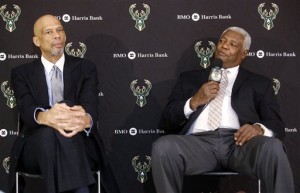by Gus Griffin
Dear Oscar Robertson:
You may have never averaged a triple-double for a whole season in today’s basketball game!
And yet I still have no doubt that you are one of the greatest players the game has ever seen.
Dear Detroit “Bad Boy” Pistons:
You may not be so bad today. The rules simply would not permit you to be. And yet you remain one the best teams of the NBA’s greatest era.
Why? Because you must be evaluated within the context of your own time. To do otherwise makes about as much sense as comparing homicide detectives before DNA with detectives after DNA. Or boasting that an administrative aide with a computer is better than one with a typewriter.
Enter the old timers’ reluctance to recognize the greatness of Steph Curry.
This saga is as much about the evolution of the basketball as it is Curry and his haters, especially the 3-point shot. It came into the NBA in the 1979-80 season…..the same year that Kareem Abdul-Jabbar won the last of his 6 league MVP awards. Fellow HOFers Bill Walton and Moses Malone won the award the previous two years. Simply put, the back to the basket dominant big man era was in full force and thus the 3-point shot was not yet an integral part of the game. The team known for annually taking among the fewest 3-point shots was the best, my Lakers. Who needs a 3 when Magic can penetrate or run the break and dish to Worthy or Wilkes, or choose Jabbar’s sky hook and you have a former league MVP in Bob McAdoo coming off the bench for much higher percentage 2-point attempts?
The first championship team to make the 3 an integral part of its offense was the Olajuwon era Rockets with Horry, Kenny Smith, and Mario Elie, awaiting “The Dream’s” pass out of the double-team, and that was 15 years after it came to the league.
It is no accident that it grew as the back to the basket big man began to go the way of the dinosaur. The stats say as Ewing/Robinson/Olajuwon left the game, the 3’s increased league wide.
Think about it: if your choice is to dump the ball into say, Julius Randle, Kevin Love, or Porzingus (on the rare occasions they actually get on the block) for a 2-point attempt with a 41-42% success rate or let the shooters go for a 3 – 40% of the time, the math makes the choice for you.
Steph Curry is but the highest example of the evolution of this process. It was delayed briefly by the Shaq/Tim Duncan era. But we can all agree that they were once in a lifetime players. It’s much more likely to find 3 or 4 poor man’s versions of Steph Curry than you will find another Shaq.
Projecting if players could do the same in another era is inherently flawed due to the failure to project the player to all the unique factors of that era, be they societal, training, or others. For example, it’s easy to say Bill Russell at 6’9 and 215 lbs would be too small to play center today. The real question is wouldn’t he likely be bigger if he grew up in the 1990s as opposed to the 1950s?
The argument can be made that adaptability is the single most common denominator among the exceptional athletes, even beyond basketball. Look at the NFL and its evolution. Seven years ago who was the poster child for the sort of play the NFL “claimed” to want to be rid of: James Harrison, the league’s 2008 defensive player of the year and maker of arguably the greatest single defensive play in Super Bowl history. And yet he will be on the field next year at age 38, why? Because he adapted.
So too would Steph Curry, Oscar Robertson, or the Bad Boy Pistons, if called upon to do so. If only the mindset of haters could do the same.
Gus Griffin, for War Room Sports


